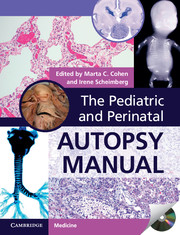Book contents
- Frontmatter
- Contents
- List of contributors
- Foreword
- Preface
- Acknowledgments
- 1 Perinatal autopsy, techniques, and classifications
- 2 Placental examination
- 3 The fetus less than 15 weeks gestation
- 4 Stillbirth and intrauterine growth restriction
- 5 Hydrops fetalis
- 6 Pathology of twinning and higher multiple pregnancy
- 7 Is this a syndrome? Patterns in genetic conditions
- 8 The metabolic disease autopsy
- 9 The abnormal heart
- 10 Central nervous system
- 11 Significant congenital abnormalities of the respiratory, digestive, and renal systems
- 12 Skeletal dysplasias
- 13 Congenital tumors
- 14 Complications of prematurity
- 15 Intrapartum and neonatal death
- 16 Sudden unexpected death in infancy
- 17 Infections and malnutrition
- 18 Role of MRI and radiology in post mortems
- 19 The forensic post mortem
- 20 Appendix tables
- Index
- References
17 - Infections and malnutrition
Published online by Cambridge University Press: 05 September 2014
- Frontmatter
- Contents
- List of contributors
- Foreword
- Preface
- Acknowledgments
- 1 Perinatal autopsy, techniques, and classifications
- 2 Placental examination
- 3 The fetus less than 15 weeks gestation
- 4 Stillbirth and intrauterine growth restriction
- 5 Hydrops fetalis
- 6 Pathology of twinning and higher multiple pregnancy
- 7 Is this a syndrome? Patterns in genetic conditions
- 8 The metabolic disease autopsy
- 9 The abnormal heart
- 10 Central nervous system
- 11 Significant congenital abnormalities of the respiratory, digestive, and renal systems
- 12 Skeletal dysplasias
- 13 Congenital tumors
- 14 Complications of prematurity
- 15 Intrapartum and neonatal death
- 16 Sudden unexpected death in infancy
- 17 Infections and malnutrition
- 18 Role of MRI and radiology in post mortems
- 19 The forensic post mortem
- 20 Appendix tables
- Index
- References
Summary
Overview of congenital infections with description of the most frequent conditions
Definition
Congenital infections are infections of the fetus or neonate that occur during pregnancy, during delivery (intrapartum), or in the immediate postnatal period. The infection may be due to ascending infection from the vagina causing chorioamnionitis, maternal fever, and leukocytosis. The infection may be due to blood spread from the mother via the chorionic villi of the placenta to the fetus, or may be due to pre-existing endometritis spreading through the membranes at 20 weeks gestation when the amniotic sac fills the uterine cavity and fuses with the endometrium.
Macroscopic features
Both the fetus and the placenta contribute to the final diagnosis. Measurements of the fetus provide a baseline for detection of abnormalities that may guide the diagnosis. The foot length provides an accurate assessment of gestational age even in the macerated and hydropic fetus; the head circumference should approximate the crown–rump length [1]. A discrepancy of greater than 20 mm suggests the presence of hydrocephalus or microcephaly in a fetus with congenital infection. A babygram (X-ray of the fetus) provides information about the skeletal system, which is frequently abnormal in congenital infections (see Chapter 18). Typical features are seen in congenital syphilis (metaphysitis) and in congenital rubella (celery stalk pattern). A babygram also shows the presence of hydrops and calcification deposited in necrotic tissue. Hydrops is a characteristic feature of congenital infection due to maternal blood spread (see also Chapter 5).
- Type
- Chapter
- Information
- The Pediatric and Perinatal Autopsy Manual , pp. 330 - 361Publisher: Cambridge University PressPrint publication year: 2000
References
- 2
- Cited by



